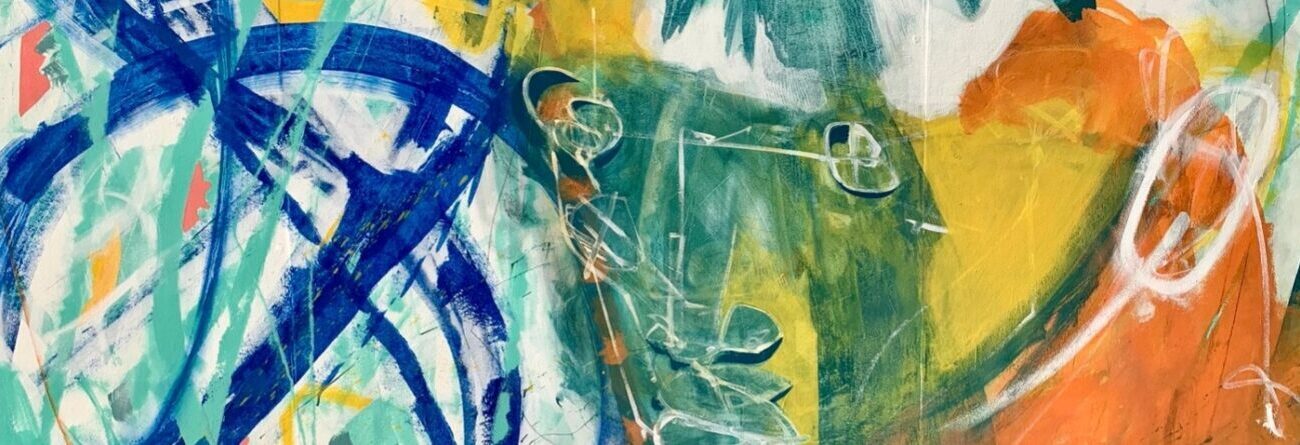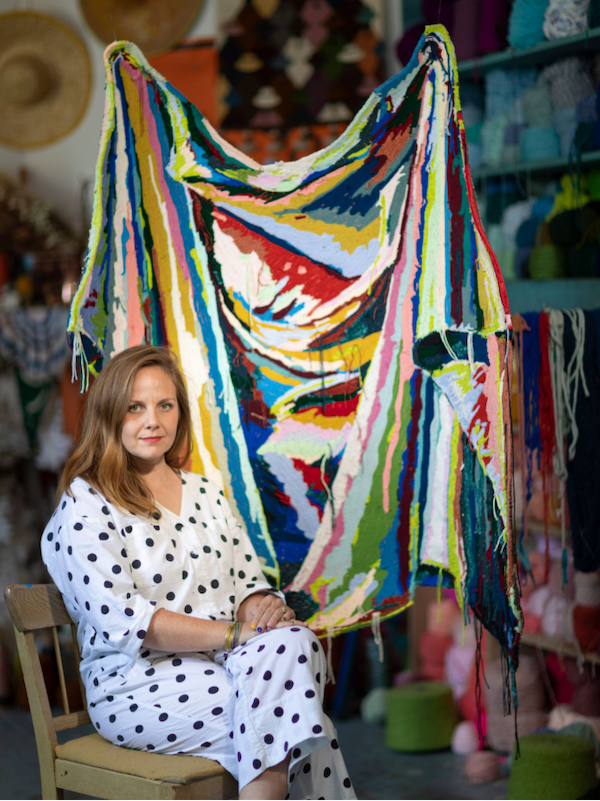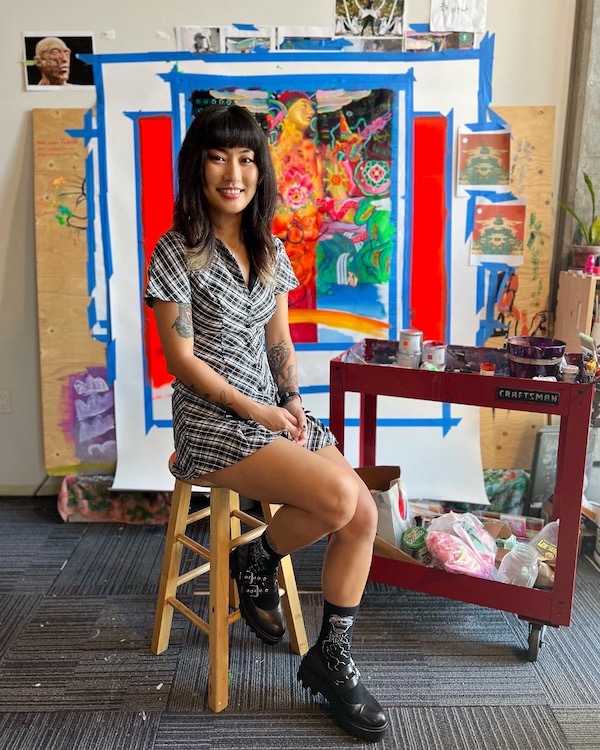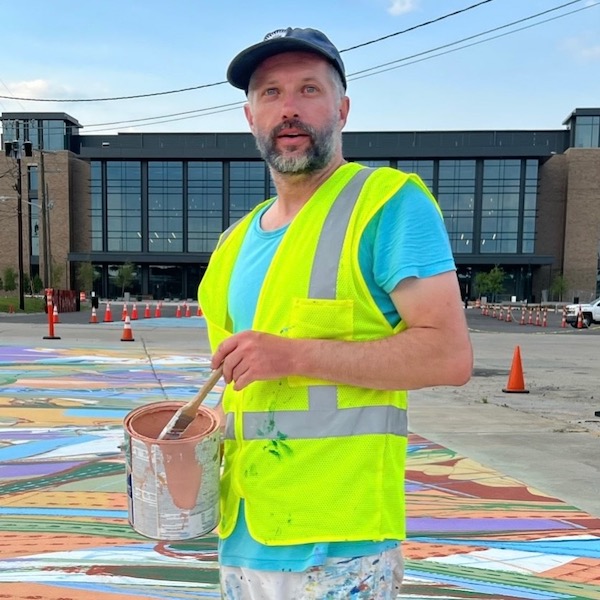
3 Creatives On the Link Between Art and Wellness
Why do artists create? Many will tell you that while the creative process is a conduit for self-expression, it's also one for healing. For our latest wellness feature, we partnered with Artrepreneur to bring you three inspirational stories about the healing power of art. Keep reading to learn first-hand about these three accomplished creatives and their journeys.
Trish Andersen, fiber artist
https://www.trishandersenstudio.com/
My first memory of creating art was in a hospital. I was diagnosed with leukemia when I was 19 months old. From the time I was two until I was five, I had to go through chemotherapy. I would get all my treatment in Atlanta at Children’s Egleston Hospital. There was an art room in the clinic run by a lady named Miss Sydney, and that’s the first visual memory I have of creating.
I remember some of the bad stuff during that time. But I also remember looking forward to when I would get to play in the art room. There was this mural when I first walked in of giraffes with donors’ names in hearts. I wouldn’t realize until I was much older that creating is how I process the world around me. The experience was training me to think, “You can visualize other things. You can find joy even as bad things are happening.”
I’ve been more or less a maker my whole life. But these past five years have been very healing for me as I've returned to tufting. The way the tool works requires a variety of elements to sync up in the right time and the right way. I use a machine, but my body has to be the same speed. All of these things need to click. Once it happens, you’re in this flow.
Then of course, color is a huge thing for me. I feel that color can be very mind opening. It has an energy to it that’s fun to play with. As I’m working, I’m constantly doing a dance with color, with texture, this push and pull of it all.
It’s also interesting to think about how what I create can be healing to other people, too. The piece I did for the Peebles Cancer Institute — I saw that as my giraffe mural. You see it as soon as you walk in. It has a calming color palette inspired by the north Georgia mountains, which is home to me. The materials are cozy yarn. It’s soft. It’s warm. It’s like a hug in a way.
Then I decided to create a piece you could actually touch. This past January, my work “Take Care” was installed at Atlanta Contemporary, and people are invited to comb the piece. It’s a huge, colorful, drippy thing. The name is a play on the phrase “take care,” which is something people say to each other in passing, almost flippantly. With the piece, I invite people to take a moment, slow down and put intention behind what you’re saying and doing.
When you groom the yarn, it’s a meditative process of zeroing in and detangling, of bringing order to chaos. As you’re taking care of this thing, you also experience something positive.
Coming out of the pandemic, I am nervous – though getting better – about touching. I thought, “Can I create artwork that is a vehicle to ease those anxieties?”
It’s been special to watch kids come in. You’d think a kid would go up and rip it down, but they become really careful. I like the accessibility of the piece.
Sometimes art can feel distant: “Oh I’m too special, you can’t experience me.” Like, why not?
Lauren Hana Chai, painter
laurenhanachai.com
Since I can remember, art has been a visual diary for me. Growing up, it was frowned upon to express how I was feeling, especially if it was negatively or about my family. I didn’t use my words. So art is what I gravitated toward.
My parents separated and divorced when I was 7. My mom moved out and had three other children. She went missing when I was 11. Even her side of the family didn’t know where she was.
In my senior year of art school, I started painting a series about my mom. It began very organically. In my personal life, I was dealing with a lot of abandonment issues and was going to therapy for the first time.
I found these old photos of my mom when she was my age at the time. It was so trippy because we looked so much alike — like looking into a mirror. The best way for me to learn about something is through art. I started drawing her face, just for myself. It led to a painting based on a photo of her and me when I was a baby, set in Los Angeles on Sunset Boulevard, which is where she used to live when we were still in contact and would send letters back and forth.
It ignited something in me. Going to therapy, talking about my mom, painting her – all of it culminated and was such a healing process for me. I started painting a series of her last six known locations. It was like Pandora’s Box opening. I could admit what was going on and finally heal from it, let love into my life and try to love myself. As the series progressed, the palette of each painting became brighter and brighter.
I wanted to elicit strong emotions from the viewer. That’s always stuck with me. I think that’s because I’m putting a lot of emotions on the canvas. I was so stunted with my own self-expression and my words. My painting is a way of communicating and connecting with others through art, like a language. I think art saved me.
Lately I’ve been working on a new project called “Missed Connections,” a video interview series of artists who have someone missing in their lives. We have conversations about their own practice and how their trauma bleeds into their art. It’s almost like therapy where we find mutual healing together.
It feels really good to do this. I focused so much on my own story. It sometimes gets so heavy. It’s nice to reach out and expand to others instead of just myself.
Matt Hebermehl
hebermehl.com
In early 2020, I was on a mural job in Atlanta and had just gotten back home to Los Angeles. The news of the coronavirus was in other places, so it was this thing we were all joking about. Living in California, the sheltering-in-place thing was imminent, so I started chilling at home. I leaned into this time of things slowing down. I started reaching out to people over FaceTime — a communication device I had been uncomfortable with for a long time — and I got an idea: “Hey, I’ll draw your picture if anybody wants to FaceTime.” For me, it was a way to reconnect with people.
With each post to Instagram, more people said they wanted to talk. I was on the phone for hours a day. For the most part, each call was an hour long. Some were two or three. Everyone had the time to check in.
Some of the people I talked to said they felt really lonely. It was odd, but I never felt alone in that whole time. I was in a relationship and had a roommate, so I had that structure of regardless of if I had the project. It was strange to have that feeling of building this community in a time of isolation. I was really lucky people were in a position to participate.
I built a book of it to have a tangible record of those moments. “COVID Calls” contains 59 drawings. It was a catalyst to move my work in a different direction. The project changed my practice to focus more on representational work. When I wasn’t doing the FaceTime calls, I was doing more observational work in and around the house with plant life and things like that. FaceTime gave me the setting and time to have models, to draw from life. There is a certain flatness to the work that comes from the screen. Any sort of shading was to capture the anxiety of the moment. From the book, I got this opportunity to illustrate a political satire book, “Thank You Donald Trump.”
Now I feel the work I’m making has more figurative elements to it, while still maintaining a gestural quality of the mark-making. It was interesting to see all the figurative and observational drawing I had done, and again have those elements come through in my two mural projects in May and June 2022... like the Elmwood Square Apartments mural in Buffalo, New York, with Artrepreneur.
From the project, I realized that I’m a better visual communicator than I am a verbal communicator. A lot of the emotions and deep stuff that I’m trying to figure out and process gets translated into the pictures that I make. The mark-making is an expression of the things I’m processing in my life and the world. It’s cathartic and it’s to problem-solve a bit, too. I made this initial gesture; what else can be built upon this? If I’m frustrated with the picture, I trust myself to keep going with it — that there will be some resolution at the end that will be compelling.
If things are bad or tough, you’ve got to keep going. The thing you weren’t expecting to happen could end up being the greatest thing ever. Human history shows us it’s in our DNA to create pictures to tell a story or communicate our lives, dating all the way back to cave paintings. It’s in our species to do this.
I know that some people feel they stop communicating visually as a child. In school, when it becomes an elective, you have people get caught up if in it’s good or bad. But then what happens when people have time as they get older? They start painting and drawing again. I think when people are given that ability, there is a natural therapy that happens.
Some people decide to try to make a living at it and go to market with these things, but the therapeutic element of it has nothing to do with whether it’s good or sellable. It’s the doing it that counts. You’ve just got to show up.
Editor's Note: The featured image atop this story is a detail from Matt Hebermehl’s mural “Hot ‘n’ Cool” (2022), commissioned by Artrepreneur for Elmwood Square Apartments, a Related Affordable property in Buffalo, New York.
This guest post for Related Life features reporting and editorial contributions by Allison Stice, editorial director at Artrepreneur, a global digital marketplace and membership platform that empowers artists to succeed and connects art buyers with curated works. As the first platform for the arts to earn Certified B Corporation status, Artrepreneur is a purpose-driven business dedicated to creating an inclusive community of creative talent from around the world. Follow @artrepreneur_og or visit artrepreneur.com for more.
Be sure to follow Related Life on Facebook and Instagram for the latest events, news and announcements in your area, and tag us for a chance to be featured @therelatedlife and #therelatedlife.


